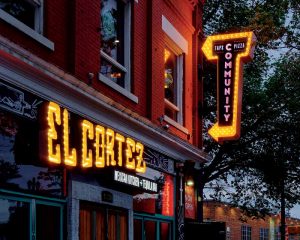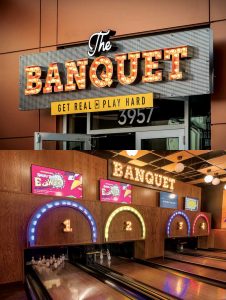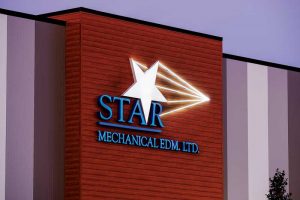Lighting the path for the future
by carly_mchugh | 10 February 2023 12:45 pm
 [1]
[1]Some of the key reasons LEDs are becoming more popular for sign projects are their low voltage requirements, longer lifespans, smaller size, greater flexibility, and wider colour variations. Photos courtesy City Image Signs
By Matthew Pennycook
The sign industry is vast in its diversity of scope, function, and design of each respective sign type, but the overarching commonality of all signage is it is made to get noticed.
At City Image Signs, our largest customer demographics fall into the commercial, industrial, and development industries. With a sample size spanning more than 2500 projects over the past seven years, we have found one of the most prominent ways for clients’ signage to stand out is through illumination.
The ins and outs of LEDs
While the history of sign illumination is long-standing, the progression of technology in how signs are electrified and illuminated has advanced tremendously, which has led to more creative and unique approaches to signage design. From incandescent bulbs lighting up the world’s first illuminated sign in the late 1800s to the transformative years of neon and fluorescent lighting spanning much of the 20th century, one of the most influential contributions to signage illumination over the past 140 years has been the advancement of LED technology.
LEDs have been around for some time and are now among the most common methods of lighting everything from houses to streetlamps to signs. Many reasons account for this shift, including (but not limited to) the low voltage requirements, which save on power and operating costs; the longer lifespan compared to many prior lighting technologies, which helps cut back on maintenance costs; and the size, flexibility, and colour variations, which provide a broader canvas for use.
While the low power consumption and extended lifespan are definite advantages of utilizing LEDs for sign projects, the small size, flexibility of use, and variety of colours are the true benefit for the many creative minds in the sign industry. Over the years, we have worked fervently with our clients to help pair their designs and budgets with the creative use of LEDs, to help their signage get noticed by using imaginative approaches to illumination. From sales to design, production, purchasing, operations, and beyond, our entire team has recognized the success in utilizing LEDs creatively for the benefit of our clients—and in turn, so has the Canadian sign industry.
Enlightening sign design
 [2]
[2]The Banquet project in the University (Foothills) district of Calgary incorporated a variety of different techniques for using LEDs, across an exterior and interior package totalling six signs.
The Banquet, Calgary
City Image Signs has been honoured with three Best of Canada’s Sign Industry Awards (BOCSIes)—twice with respect to commercial tenant signage, in 2020 and 2022. The most recent project to receive an award was The Banquet in the University (Foothills) district of Calgary, where our approach to design and production incorporated a variety of different techniques for using LEDs, across an exterior and interior package totalling six signs.
The amber-coloured, 2700-Kelvin (K), marquis-style LED Edison bulbs incorporated into the open-faced “Banquet” letters act as a nod back in time to the original signage illumination style of the late 19th and early 20th centuries. However, rather than the original incandescent bulbs, which have a limited lifespans compared to LEDs, these custom-made, Underwriters Laboratories (cUL)-certified LED bulbs offer the historical charm of yesteryear, while providing the benefits of low power consumption and a longer runtime.
Further, in contrast to the LED marquis bulbs, we also incorporated white, 7200-K LEDs into the face-lit channel letters for the word “The,” as well as the face-lit cabinet sign which carries the bar’s tagline, “Get Real, Play Hard.” The use of the LEDs in the channel letters speaks to a much more efficient face-lit opportunity than what neon or fluorescent lighting has been able to provide in the past. The same can be said for the illumination of the rectangular “Get Real, Play Hard” cabinet sign. While incandescent or fluorescent lamps were the predominant approach to the squared-off, 90-degree-angled sign cabinets of the past—and could have been used in this project—the increased affordability of now-mass-produced LEDs, the longevity and consistency of the products, and the ongoing savings in maintenance costs make them the optimal choice, even where other options still exist.
The interior signs feature similar marquis bulbs and additional push-through elements which are illuminated with LED modules. These signs also contain dimmers, so the facility is able to control the brightness of their signage, based on their preference for various events and other circumstances.
In short, The Banquet project is a clear example of the opportunities that advancements in signage illumination—and specifically LED technology—have had in opening the door to creative and cost-effective design and fabrication solutions.
 [3]
[3]The Star Mechanical project in Edmonton featured white LED flexibright rope, to mimic a similar look to neon.
Star Mechanical, Edmonton
Another sign our team was privileged to be recognized for was the fascia sign for Star Mechanical in Edmonton. It was awarded “Best of Show” in Signs of the Times’ 2021 international sign competition.
While not an overly large sign, the thought and diligence put into the multitude of depths, sign types, and illumination methods made it a true “star” of the industry. Our team fabricated the face-illuminated channel letters out of various depths, which housed white LED modules. This took precision and extra testing to ensure the different depths illuminated properly with the respective quantity and spacing of LEDs installed into the sign. The “starburst” section features white flexibright rope lighting, which mimics the look of neon.
Similar to the incorporation of the marquis-style Edison bulbs into the “Banquet” sign, the inclusion of the white LED flexibright rope acts as a tip of the hat to the illumination methods of the past. Rather than the high voltage, high power consumption, and relatively higher upfront fabrication costs of neon, this very similar look was achieved using a low-voltage, low-power-consuming, more cost-effective rope LED product which satisfies the look the brand deserves and at an overall reduced cost compared to what neon might have offered.
The simplicity of the final product, paired with the technical preparation required in production for the sign to illuminate brightly and consistently—despite the variable depths and illumination methods—has this sign on our list of favourites.
Moving forward
These two projects represent just the tip of the iceberg with respect to what is possible when using LEDs in signage. However, they clearly highlight how advancements in LED technology can be of substantial benefit to the customer and their wallet, while still incorporating aspects of similar design and fabrication techniques from the past.
Further, while we are eager to see where advancements in technology take these products next, it is always important to ensure that when fabricating, purchasing, and installing electrified signage in Canada, the LEDs—along with their corresponding power supplies and electrical components—meet or exceed the certification requirements of the Canadian Electrical Code (CEC). Certified LED and electrical products are some of the best materials for sign shops to create dynamic and cost-effective projects that get noticed, and in turn, benefit the client, the company, and the skyline.
Matthew Pennycook is the president and co-owner of City Image Signs in Edmonton. He currently sits on the board of directors for the Alberta Sign Association (ASA) in the capacity of vice-president and is a director for the non-profit organization Active Communities Alberta.
- [Image]: https://www.signmedia.ca/wp-content/uploads/2023/02/ElCortez-Community-TP-Wide.jpg
- [Image]: https://www.signmedia.ca/wp-content/uploads/2023/02/Banquet-1.jpg
- [Image]: https://www.signmedia.ca/wp-content/uploads/2023/02/Star-Mechanical-Close_V1.jpg
Source URL: https://www.signmedia.ca/lighting-the-path-for-the-future/